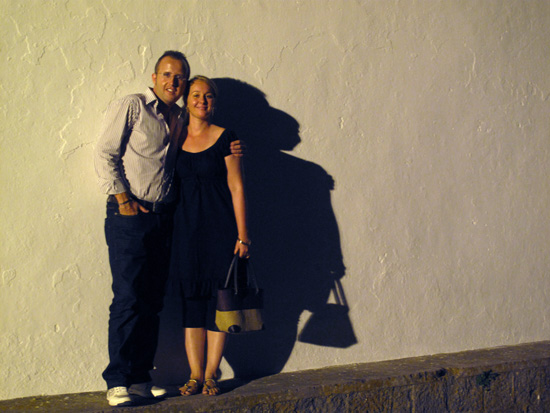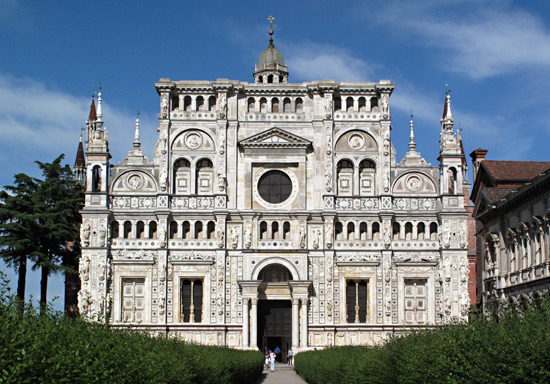
by Maureen | Jun 3, 2010 | Canals, Certosa di Pavia, Church, Discoveries, Featured Articles, Incredible Locations, Journal, Photo of the Day, Photos, Quips
A sunny holiday in the middle of the week calls for a bike ride. Apparently every family in Milano had the same thought; the bike path along the canal was crowded with those rolling tra-la-la along. I, on the other hand, felt full of vim and vigor so I pushed myself hard for an hour until I was further along the canal than I had gone before: Certosa di Pavia.
What a beautiful little town about 15 miles south of Milano. I saw spires to the east and followed them to a gem of a church I had been unaware of.

“The Certosa di Pavia Gra-Car (“Charterhouse of Pavia – Gratiarum Chartusia”), Shrine of the Blessed Virgin Mary Mother of Grace, is a monastery and complex in Lombardy, northern Italy, situated near a small town of the same name in the Province of Pavia, 8 km north of Pavia. Built in 1396-1495, it was once located on the border of a large hunting park belonging to the Visconti family of Milan, of which today only scattered parts remain.
Certosa is the Italian name for a house of the cloistered monastic order of Carthusians founded by St. Bruno in 1044 at Grande Chartreuse. Though the Carthusians in their early centuries were known for their seclusion and asceticism and the plainness of their architecture, the Certosa is renowned for the exuberance of its architecture, in both the Gothic and Renaissance styles, and for its collection of artworks which are particularly representative of the region.”
(Read more in Wikipedia.)
I enjoyed the verdant courtyard between the entry gate and the church’s door, and marveled at the detail-laden exterior. Photos were not allowed inside of the church, nor were such casual, immodest clothes as biker’s lycra, so I could only stand at the doorway and peer in at the vaulted, starry ceiling overhead.
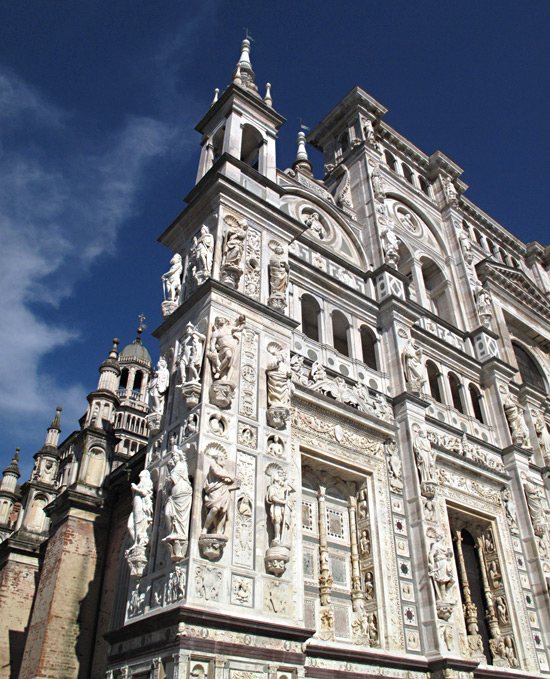
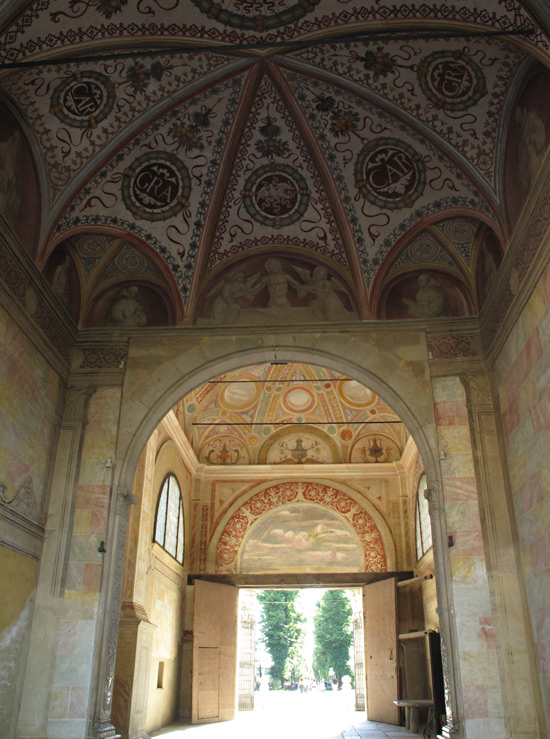
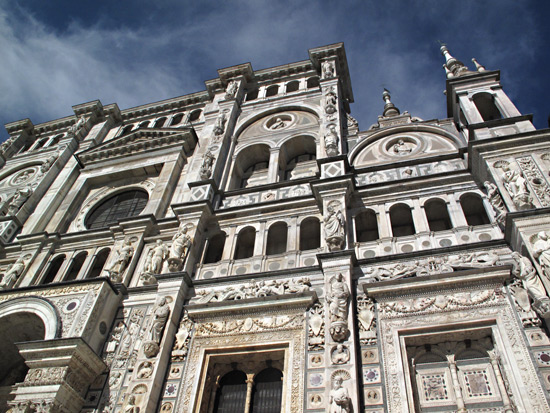
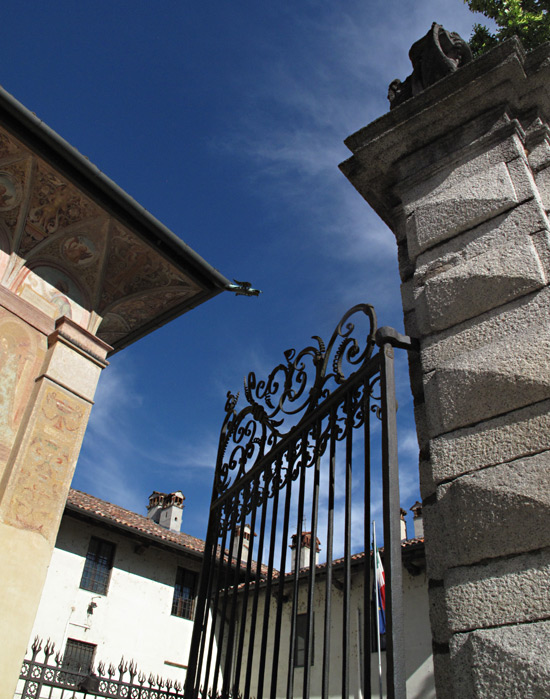
How wonderful to hop on my bike, discover a place I hadn’t seen yet, and unexpectedly see something so beautiful! As I rode away, the sun was bouncing off the rice paddies alongside the church compound. The wind picked up strongly and required that I shift gears to ride against it, arriving home in advance of a northern storm that loomed dark but never materialized.
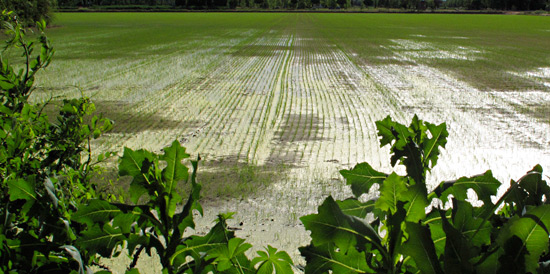
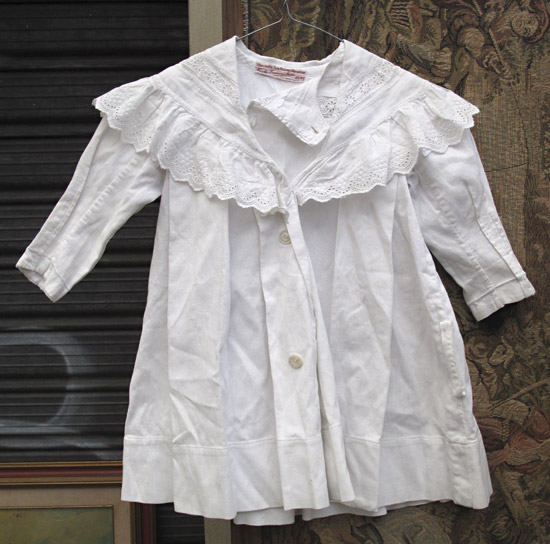
by Maureen | Mar 30, 2010 | Featured Articles, Firenze, Incredible Locations, Journal, Photos, Shopping & Markets
A month ago I was given a hot lead from a girlfriend in Seattle about flea markets in Firenze. What I uncovered through some digging was that the “hottest” market happens on the last Sunday of the month, in the Piazza dei Ciompi, just a few blocks’ walk east of the Piazza del Duomo. OK. That little fact determined the timing of my return visit to Firenze.
I even set the alarm Sunday morning(!), ate a quick breakfast and started walking the mile to the piazza. Along the way, I kept seeing people carrying branches and scratched my head over that. Hmm. Oh! It was Palm Sunday but they were carrying olive branches, not palms! I stepped into the Basilica della Santissima Annunziata mere moments before mass started and witnessed the procession of priests and parishioners.
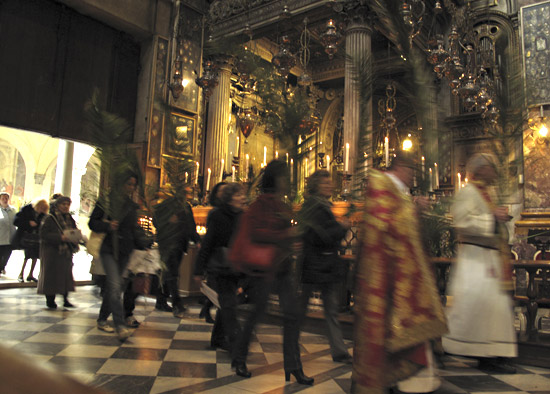
The portico between the church and the “cloister of the dead” offered a heaping bale of olive branches, so I plucked a few little twigs to carry in my pocket, then continued my mile walk.
When I arrived at the Piazza dei Ciompi, I found many of the things I expected AND I found most everything I was looking for. On the last Sunday of the month, the flea market spills out into the side streets, populated by many of the local antiques dealers surrounding the piazza. There are the vendors that know what they have and charge high prices accordingly. And there are those that have a mixed pile of junky tidbits with a “treasure” tucked in here and there. The concept must be universal among flea markets and swap meets.
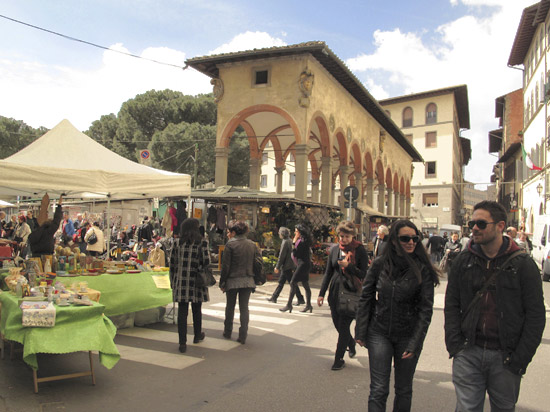
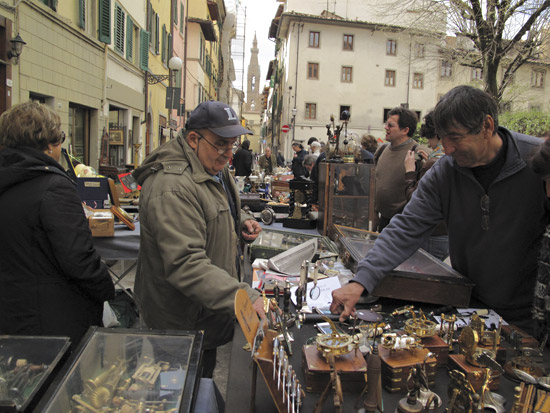
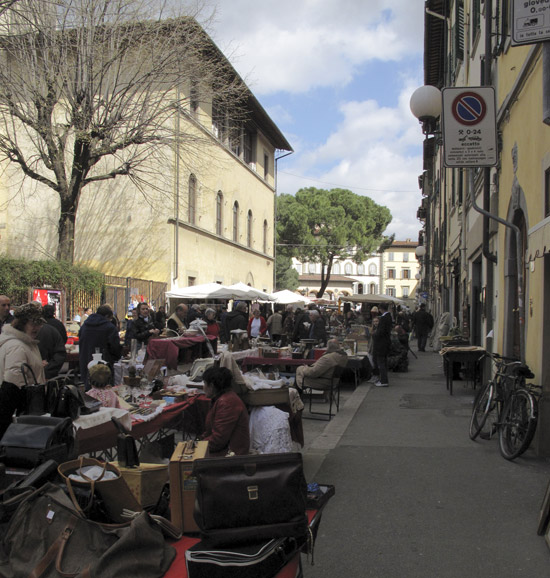
Of course there were iron pieces, linens, books, figurines, clothing, costume jewelry, housewares and miscellanea. What I went in search of were red-stitched linens (thinking of my great, great grandmother and Frette linens) and old penmanship guidebooks. I found both! What I didn’t find are the meat and milk signs like I’ve seen hanging outside markets around the country. I’d gladly hang them outside my door at home in Seattle!
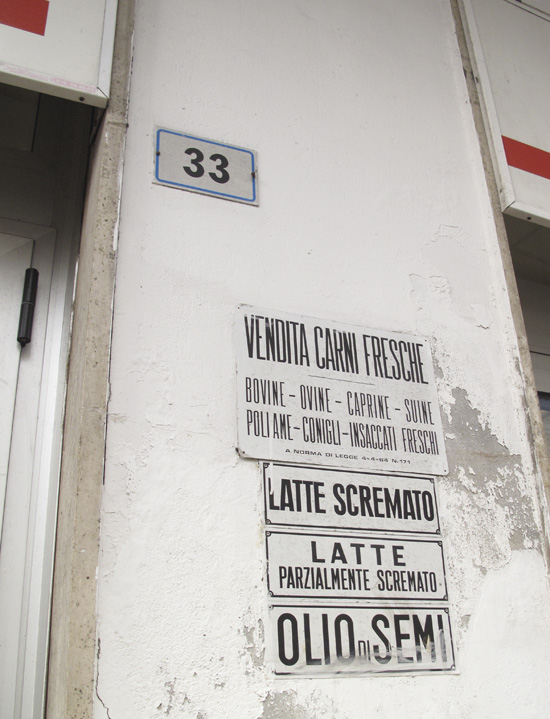
Look at these hat forms! The vendor had about a dozen of them. Many different hat shapes. Beautifully-sculpted hardwood! If I remember right, they were selling for about 80 euro each (about $107).
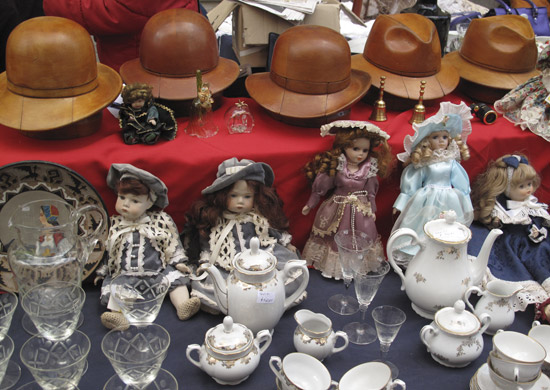
Years ago, both of my Grandmas let me paw through their button boxes and select my favorites. I now have a collection of thousands of buttons, especially mother-of-pearl. I dig into my collection when I’ve sewn something and need just-right buttons. When I saw these boxes full of buttons, I was hopeful, but in the end unwilling to pay 50 cents per pearl button.
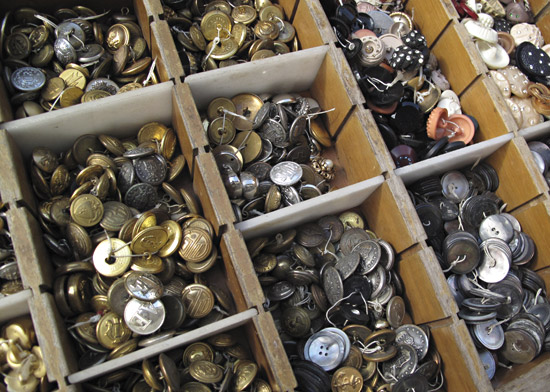
This lovely, white, cotton-with-eyelet dress from Roma was hanging toward the back of one seller’s stall. Darn. It wasn’t for sale. I would have brought it home to little 5-month-old Audrey, whom I haven’t even met yet (!)


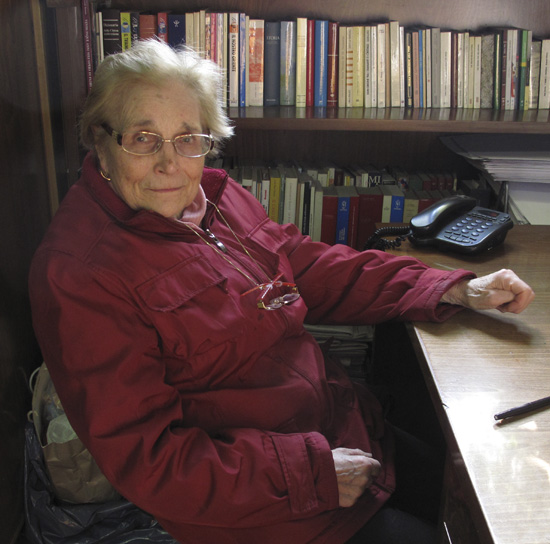
by Maureen | Mar 18, 2010 | Discoveries, Featured Articles, Journal, People, Photos
Last June, just a few days after I had arrived here in Milano, I went to the Cimitero Monumentale – the Monumental Cemetery – to look around. It is, indeed, “monumental” and every bit worth an afternoon of strolling and looking. As they say, it is WAY over the top! One can study architecture, sculpture, typography and history. The structural monuments are bigger than my apartment and of every possible architectural style. Every family grave plot features a noteworthy sculpture. That cemetery provides a very concentrated study location, like none other I know.
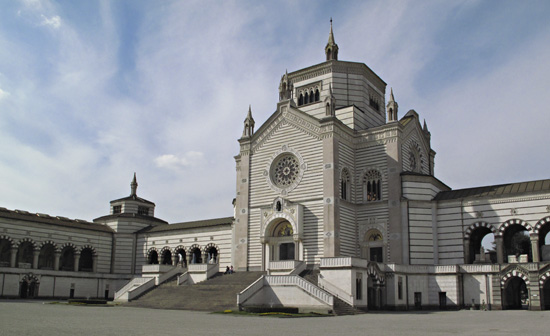
So, back to Mary. In June, after being awestruck by the cemetery grounds themselves and feeling saturated by it all, I started toward the exit, through the main “gallery” building. I heard chanting and the monotone of prayer, and it changed my course. Around back and in the lower level is a small chapel. I approached the doorway and simply stood outside, listening to the rhythm of women saying the rosary. At the doorway was a simple stand with a listing of the names of the recently deceased, for whom the women were praying.
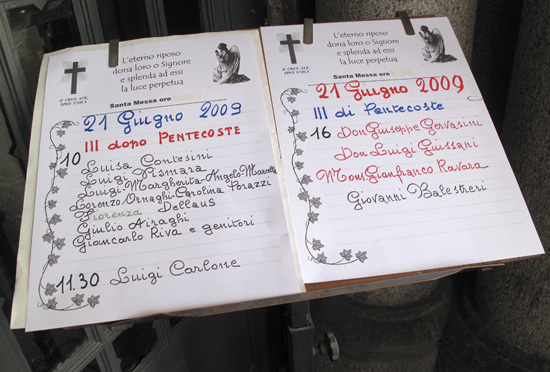
The handwriting stopped me! SO unlike what we learned long ago in school in the U.S. So European. So distinctive!
Lately, as I have continued to intensively “mine” Milano for design references, that very particular handwriting has pulled at me. I went back to the cemetery on Monday, to shoot the day’s page of names, however, the cemetery was closed. I went back again today and made a bee-line for the chapel front. Yes! There it was. That lovely, lyrical, not-quite-cursive pen! I photographed each of the 3 sheets posted there, then turned north for a tour of the cemetery.
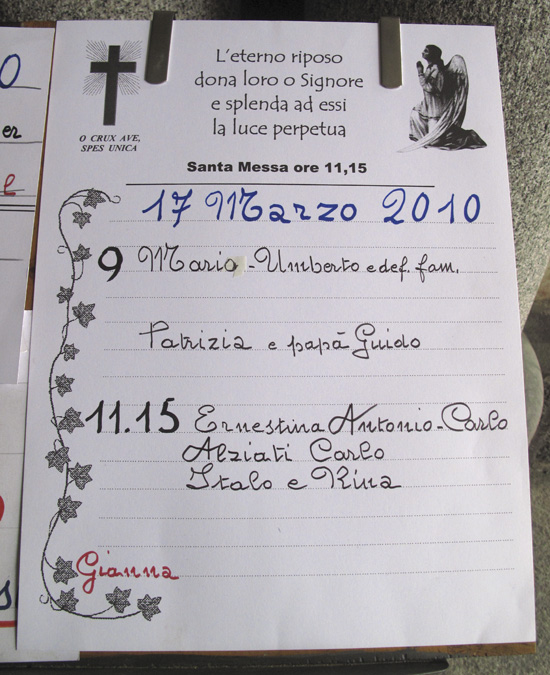
Mary’s capital letter “M”:
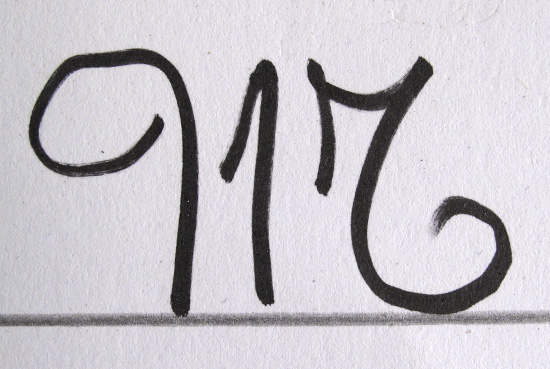
During my slow amble, one of the cemetery workers approached me and asked if I wanted to see the Campari tomb. (This cemetery holds the remains of all the “big-name families” of Milano: Campari – the drink, Ferrari, Pirelli, Zucchi and many others. The sources of all the street names in town!) Of course I said yes, and he, Salvatore, took me to the northwest area of the grounds and to the grand tomb capped by a sculptural “Last Supper”. At it’s backside was an open vault with a beautiful mosaic covering walls and ceiling.
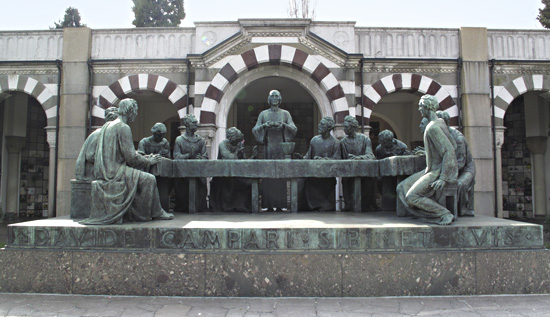
While Salvatore and I chatted, I showed him the pictures I had shot of the wonderful handwriting. I asked if he knew who had done it and said that I would like to meet her. (It speaks of femininity, so I assumed it was a woman.) I didn’t understand everything he said, but it was something about 3 o’clock and come back another time. (It was then about 1:30.) I thanked him for his help, said goodbye and kept looking around.
Time flies in that incredible cemetery. It would be hard to tire of that place, impossible to cease seeing something new. I saw Salvatore again and it was after 3:00. He suggested that I might be able to meet the person that wrote the pages, so he took me to the brown-cloaked priest and I explained who I was looking for. Father signaled for me to follow him, and we wrapped through the crypt-filled hallways to a nondescript door which led into the back of the chapel. He took me through a few interior halls to a room with a western window and the afternoon light… and Mary.

I told her how beautiful her handwriting is and that I couldn’t stop thinking about it lately. It’s the most beautiful and distinctive I’ve seen here. Using all the “polite” Italian I could remember, I asked her if she would kindly write out an alphabet and number set for me, with upper and lower case letters. She seemed tickled and agreed, but asked if I would come back another day to pick it up. She wanted time to do it well.
Part of today’s list of names speaks of Don Giuseppe Gervasini, a priest that lived from 1867 to 1941 and is believed to have special healing powers. Mary – pronounced more like “Mah-ree” with a light trill to the “r” – carefully shuffled some papers in a deep drawer in her office and removed a wallet-sized photo of Father Gervasini. She gave it to me and instructed me to keep it with me always, saying that Don Gervasini would keep me protected. (A mass is being held in the chapel this Saturday at 10:00 in honor of Don Giuseppe Gervasini’s “name day” – onomastico. I guess I know what I’m doing Saturday morning.)
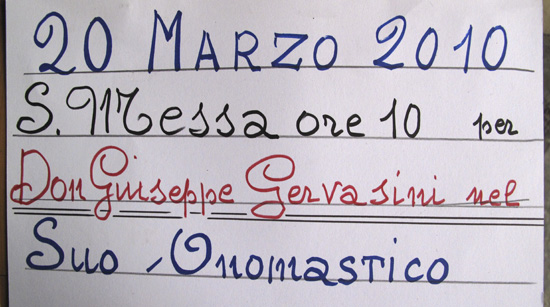
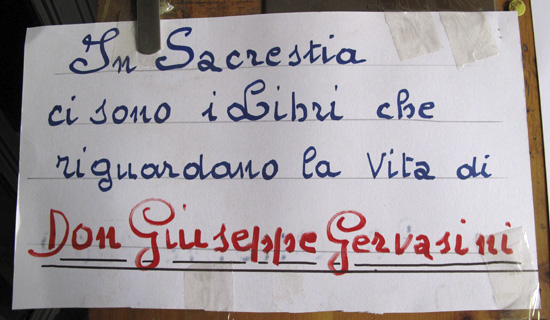
“Mary, Salvatore told me that you’re 84 years old.” “Yes. How old are YOU?” When I answered, she said, “I thought you were 30! You look like it!” I told her she’s sweet for saying so. She gave me a kiss on each cheek goodbye and I told her I’d be back tomorrow to come pick up the alphabet. (I’ll take her some flowers and some greeting cards that I made, as a little “thank you”.)
I absolutely beamed all afternoon as I left the cemetery! To have not only seen more of the handwriting I enjoyed so much, but to MEET the woman that does it, AND to have her agree to write out a full alphabet for me, AND to have her be so sweet to chat with… And I have such fondness for elder women. It is exactly these unexpected, unplanned, never-to-be-imagined meetings that charm my time here in Milano.

by Maureen | Jan 26, 2010 | Bergamo, Discoveries, Featured Articles, Incredible Locations, Journal, Photos
After rising up from the valley floor in the funiculare tram, a short walk brings you to the old plaza, la Piazza Vecchia. Encircled by palaces, a bell tower and a colonnaded portico, the space is punctuated at its center by a Baroque fountain from the late 1700s. The piazza is the heart of the city.Those palaces now house restaurants, hotels, a school and a museum.
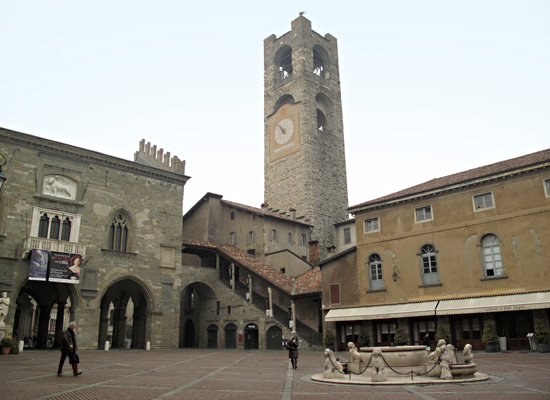
Passing through the portico (at the left in the photo above, under the banners) you find a white marble sundial that was set into the ground in 1798. It points the way north. (It seems to have been restored in 1982.)
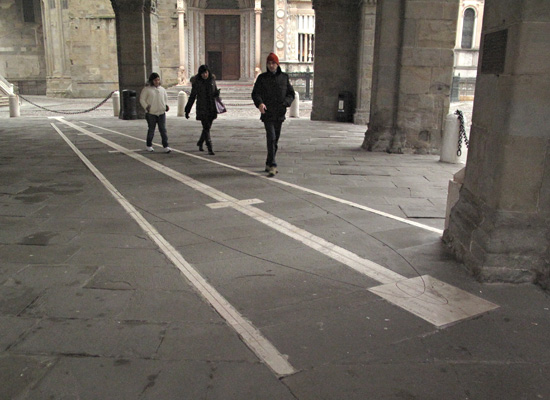
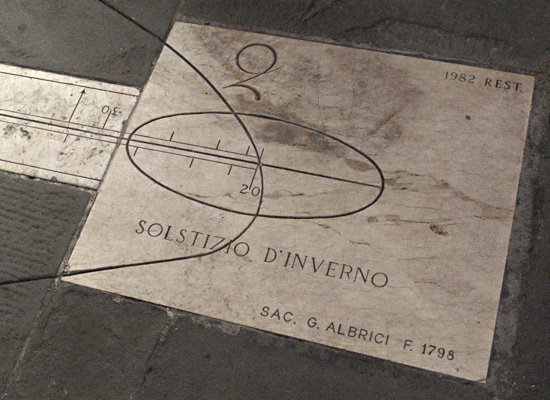
Just beyond the other side of the portico, you step into the Piazza del Duomo, the Plaza of the Cathedral. In mediaeval times this little square was at the political, commercial and religious heart of town. Facing south into the piazza, from your left to right is the Cattedrale di Bergamo (il Duomo), the Basilica di Santa Maria Maggiore, the Cappella Colleoni and the Battistero (Bapistry).
Cattedrale di Bergamo – il Duomo
The ceiling of the Duomo featured gilt patterning and accents to its carved decorations surrounding painted scenes.
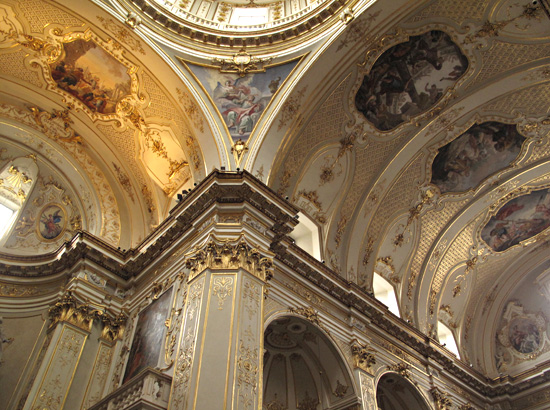
I have a real soft spot for the shrines to Mary. This Madonna della Pietá is in an elaborately carved and embellished side altar.
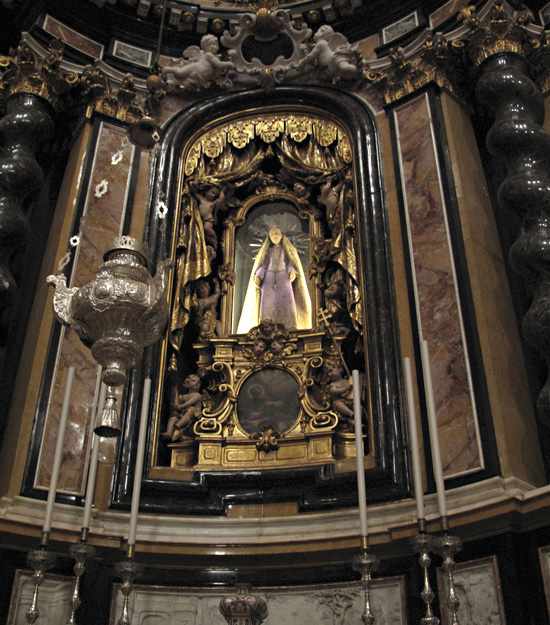
While in the cathedral, I heard chanting and thought perhaps they were playing a recording “for ambience”. No. I followed the singing which lead me down a staircase near the altar. I came to a very modern underground chapel and 50 Nuns at mass, surrounded by a dozen sarcophaghi.
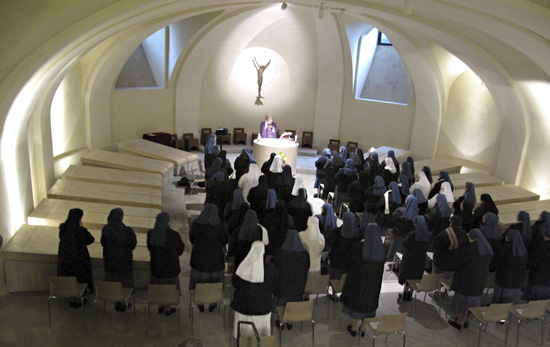
The dominant presence in the Piazza del Duomo is the union of entrances for the Basilica di Santa Maria Maggiore (at left in the photo below) and the Cappella Colleoni (at right).
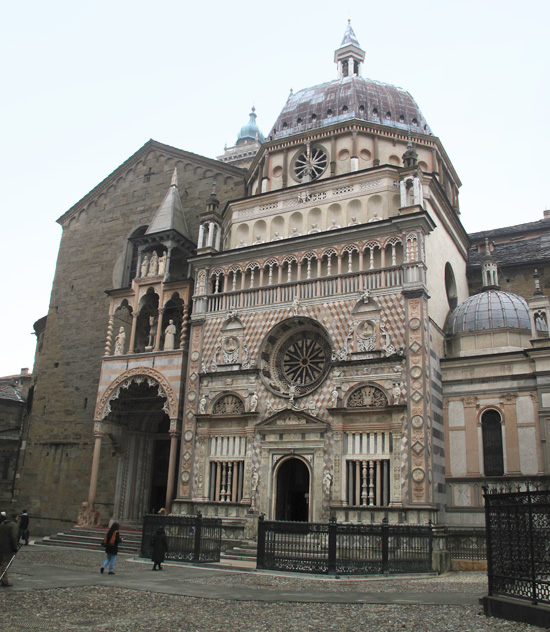
Basilica di Santa Maria Maggiore
The Basilica entry is fairly modest and overshadowed by the Chapel entry at its side. It opens, however, into a great, embellished space.
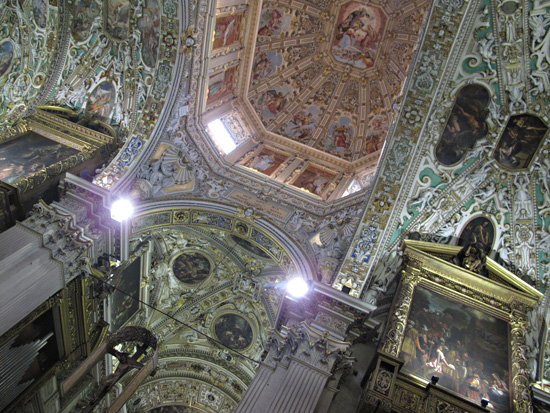
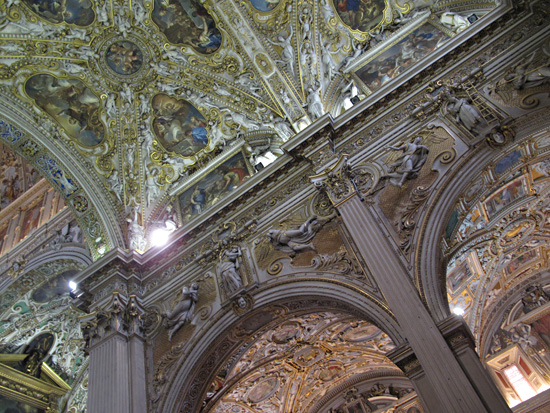
Here’s a shot of the crucifix that hangs over the central altar. (Note the skull and crossbones at the base of the cross.)
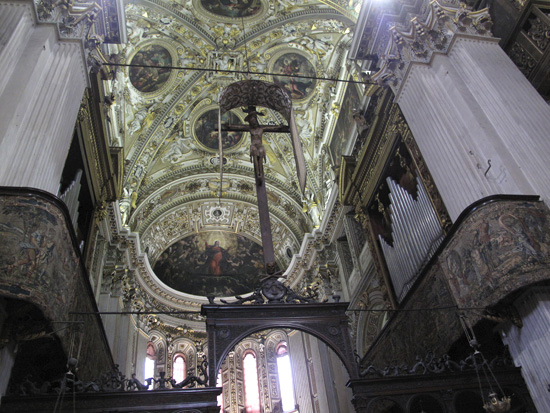
All vertical walls are covered with pictorial tapestries. (Although it was still very cold in there!)
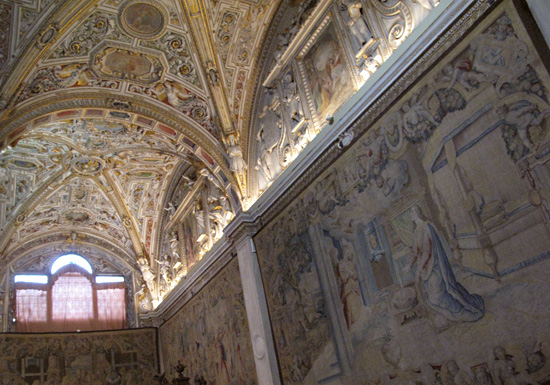
Here is historic Bergamo’s answer to today’s compact PDA/Calendar. This is how they note the times of the masses for week days and weekends.
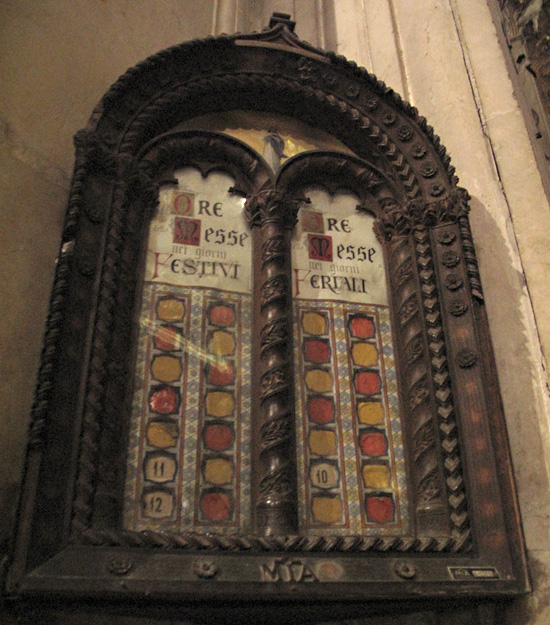
On the outside wall of the Basilica, just to the left of the front door, are permanently-mounted, flat bars of iron that are measuring devices from the Middle Ages. (I can’t find any information about their purpose or unit-of-measure.)
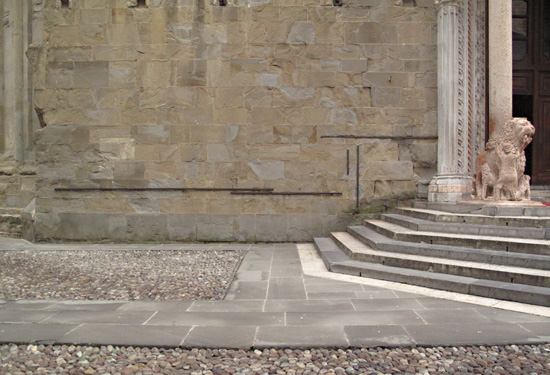
“The Weaver’s Wall” and “the Weaver’s Comb.” (?)


Cappella Colleoni
From a Wikipedia entry: “Dedicated to the saints Bartholomew, Mark and John the Baptist, it was built in 1472-1476 as the personal shrine for the famous condottiere Bartolomeo Colleoni, a member of one of the most outstanding families of the city, and his beloved daughter Medea. The site chosen was that of the sacristy of the nearby church of Santa Maria Maggiore, which was demolished by Colleoni’s soldiers.”
With its 3-D lozenge pattern, the repetition of columns, the figurative sculptures, rose windows, domes and bas-relief panels, no one and no building could compete for stature against this chapel. I think that one could study it all day, as well as the decorated fence surrounding the chapel entry. (No photos were allowed inside.)
The Baptistry
My favorite part of the Baptistry is the decorative ironwork fence around its octagonal shape/
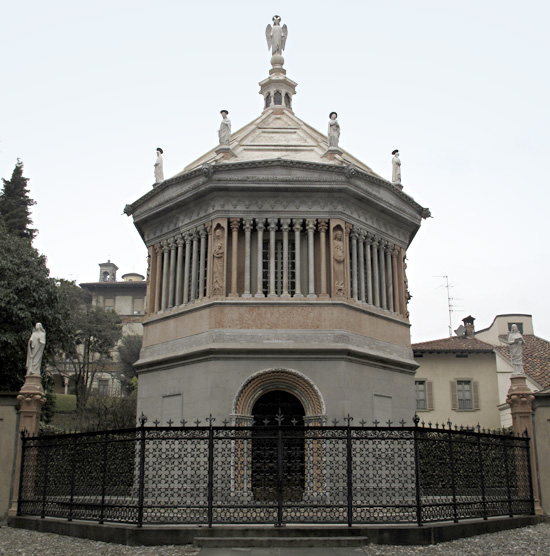
– – –
Note: So very many images and scholarly descriptions are available online that it would feel redundant if I tried to duplicate what’s already been said. I would rather toss out my own personal impressions and show what catches MY eye and mind, and provide enough information so that a blog reader could do their own further research.
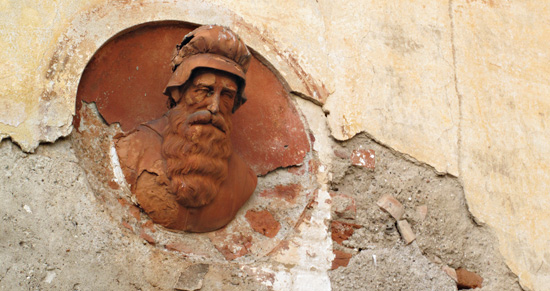
by Maureen | Jan 11, 2010 | Canals, Discoveries, Featured Articles, Incredible Locations, Journal, People, Photo of the Day, Photos
“I was born in 1945 during the war years and I grew up with family members all around me talking about politics and The War. They didn’t always agree. I think that being surrounded by these discussions as a child is why I love history so much today.”
Today Angelo became my second personal tour guide in two weeks, giving me yet another “3-hour-tour”. I just rode my bike all around the countryside southwest of Milano with my “History Buff on Wheels”.
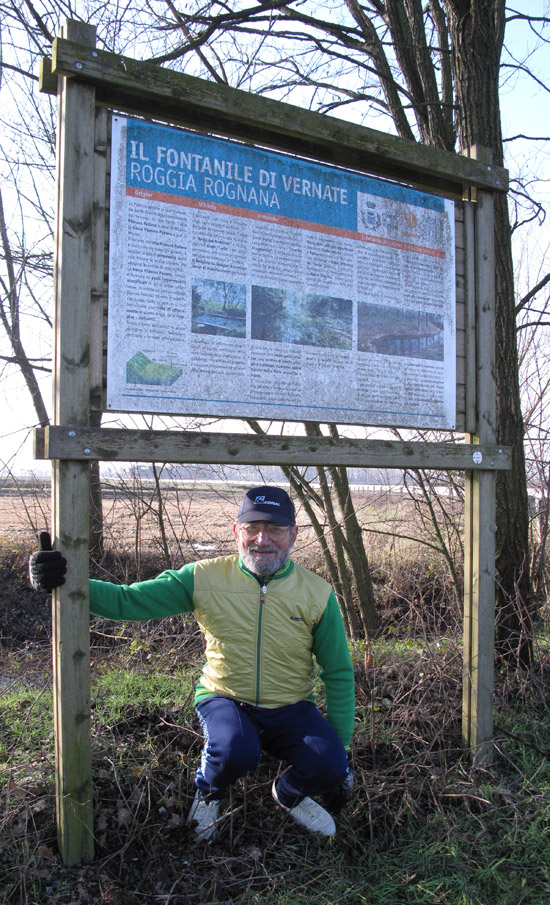
Angelo pointed out the “Fontanile di Vernate” one of the places where the spring forms a pond.
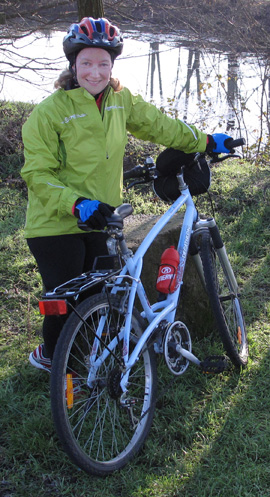
Oh yes. So lovely decked out in my winter riding gear…
When the sun came in the window this morning for the first time in ages, it woke me up and promised me a 45 degree day and my treasured, usual bike ride. I got the day, but not my usual ride. After pedaling along the Naviglio Pavese for about 20 minutes, I caught up with another rider and remarked how nice it was to be out. We talked for a minute or two as we rode, then I zipped ahead feeling full of energy and wanting to go faster. But he caught up with me. It was Angelo. We rode on, talking all the way. Feeling spontaneous and trusting, I agreed to his suggestion that we ride on further than I normally would have gone.
(I usually keep my rides to an hour and a half or two hours, and haven’t done much exploration alone on the more remote bike paths.)
Sure! Encounter some man on the bike trail and follow him all over the countryside! But of course!
We ended up riding on the narrow roads that wind between rice fields and other farm land. The whole time Angelo was relaying the history of Milan, Italy, Europe, WWII, Mussolini and Hitler… Berlusconi, Bush and Obama. He talked about the hardships during the wartime and how people were sustained by the rice of southwest Milano. (He doesn’t speak a word of English, by the way.)
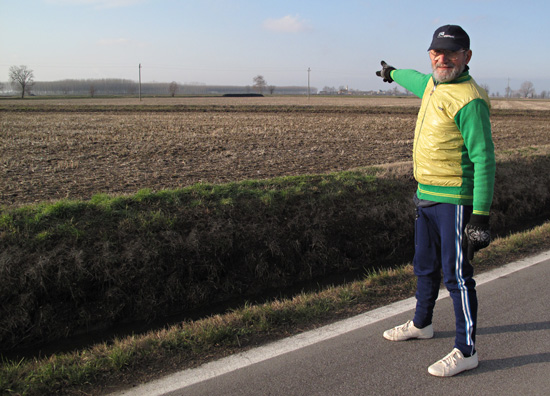
Angelo’s father’s birthplace is in the distance, where the church steeple is.
He pointed out where both his mother and father were born, and where they are both buried (Zibido San Giacomo). Angelo took me to old, fortified “cascine” – country farmsteads with castle-like main buildings and outbuildings – most refurbished and still in use as modern-day farms carrying on. He pointed out places where Leonardo da Vinci had been, worked, designed and created. Leonardo’s hand and mind are all over this local land.
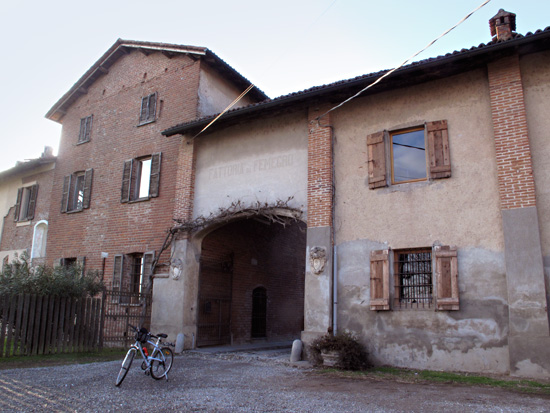
The entrance to Cascina Femegro.
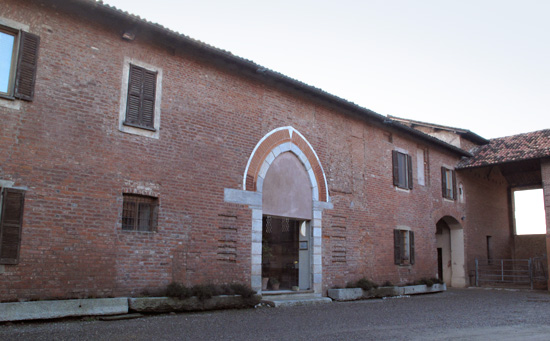
Within the inner courtyard of Cascina Femegro is this beautiful arched doorway. Straight across from it, 100 yards, are cattle in their stalls. A little girl was riding on her tricycle.
I saw a shrine in Zibido to Padre Pio (who had the “stigmata” markings matching Christ’s); the sarcophagus of San Giacomo, c. II-IX cent. – St. James – in the central courtyard of the town by the same name; and an old cascina, “Ca’ Grande”, Palazzina Pusteria Busca Pozzi.
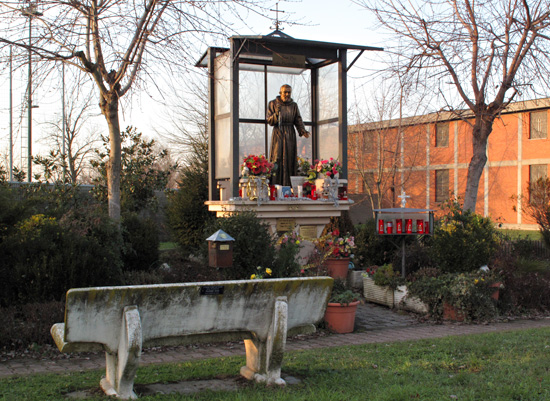
Shrine in Zibido to Padre Pio
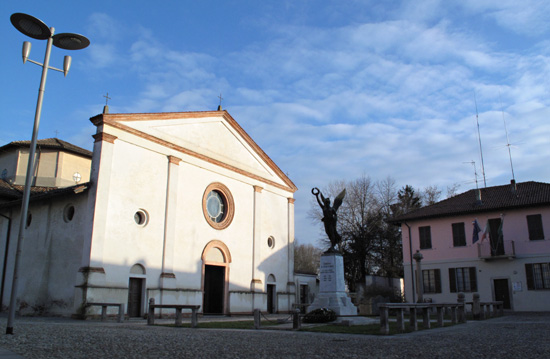
The church at Zibido San Giacomo.
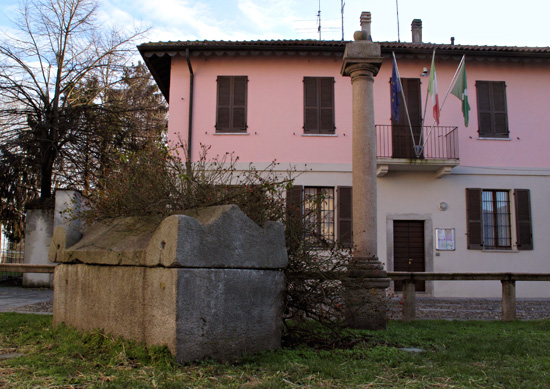
Sarcophagus of San Giacomo.
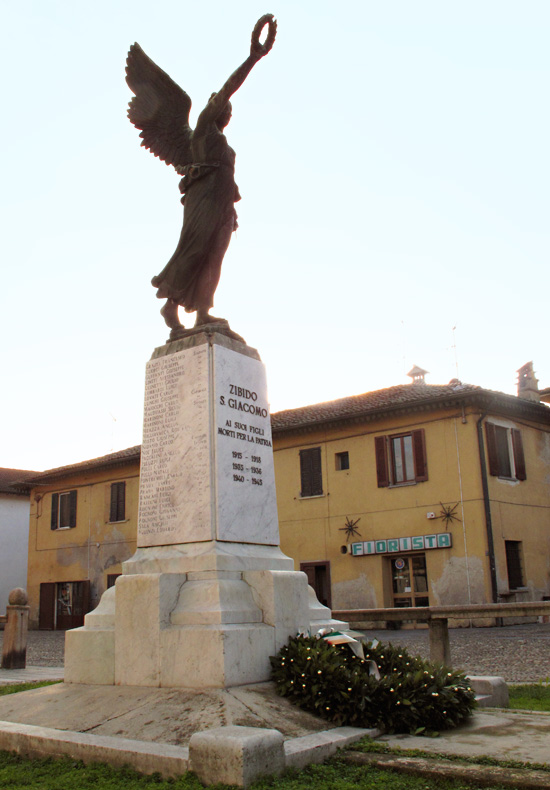
This is the memorial to those from the town of Zibido San Giacomo that have died in the wars.
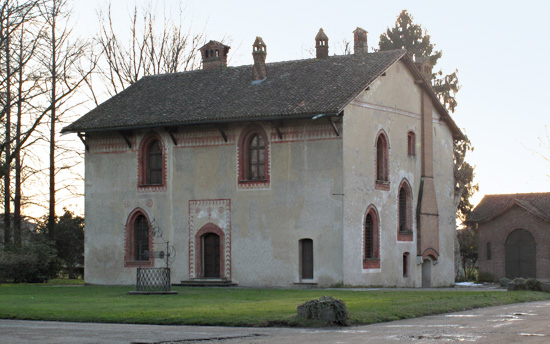
An old cascina, “Ca’ Grande”, Palazzina Pusteria Busca Pozzi.
(While riding through Zibido, Angelo’s daughter passed us in her car, going home. He rode to the house a half block away and told her about “this American woman”.)
Angelo explained the “marchite” – marshes – the rich, fertile land perennially wet from “i fontanili”, the underground aquifers and springs of the area. During the winter the ground’s surface may freeze but the ground itself is kept warm by the rising water. The farmed land has been formed into wide, humped rows, allowing the water to flow between the rows; the row peaks begin to grow grass earlier in the Spring than other locales. The milk from cows raised on this grass is said to be superlative.
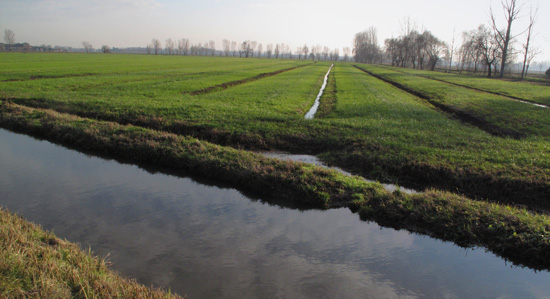
Le Marchite – The Marsh Farmlands
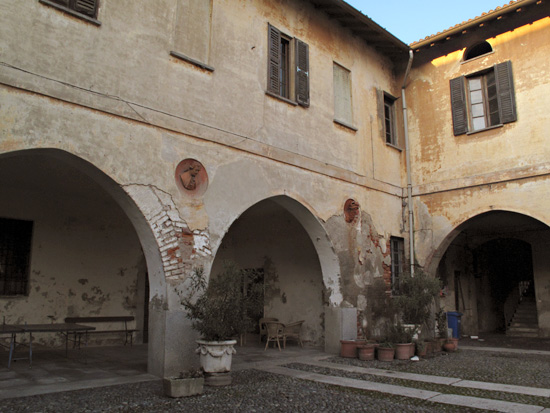
An old “cascino” back alongside the Naviglio Pavese, at the turnoff to Zibido; I think Angelo said it was “San Lorenzo”. Leonardo spent time here. In the inner courtyard, there are bas-relief busts of various people jutting from the walls.

We figured this one must be Leonardo.
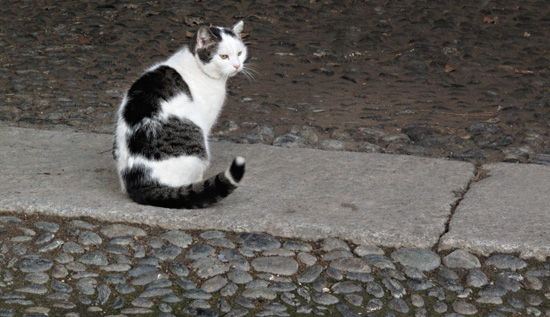
Of course there’s a cat in the courtyard!
Our route today was: South along the Naviglio Pavese to Binasco. West to Vernate and Calvignasco. North up through Rosate, back east to Noviglio, Mairano and Zibido San Giacomo. Angelo rode almost all the way back to Milano with me, to within 10 minutes of my apartment. He wanted to show me the maritime locks along the canal that Leonardo had designed.
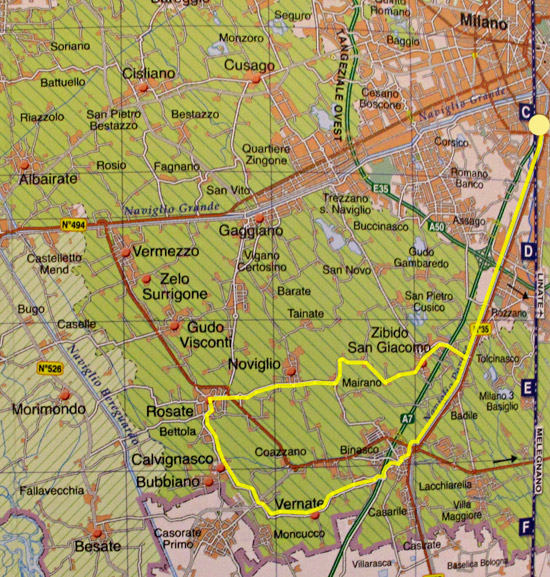
Our route – in yellow – through the farmland. My usual route is down the canal to Binasco and straight back. I’m going to feel this unusually long ride tomorrow!
He suggested I make a ride sometime to the Morimondo Abbey founded in 1136, and to the town of Vigevano to see a show of Leonardo’s work.
(I’m on stun. I could not craft these experiences if I tried!)
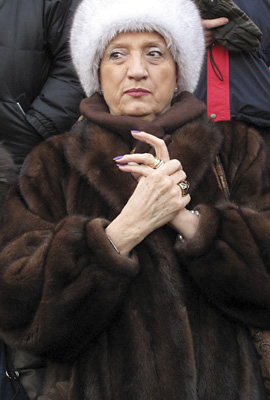
by Maureen | Jan 7, 2010 | Discoveries, Featured Articles, Journal, People, Photos
Gotta love these Italians. They had two national, Catholic holidays at the beginning of December. Then two weeks off for Christmas and New Years. Then, today is the Feast of the Epiphany, also a national holiday. (Italy is about 98% Catholic.) A lot of people took this whole week off since they were already on a two week break and why come back for two days, have one day off, and then come back for two more days before the weekend? Might as well extend the two weeks into three.
There was a parade through town for the Epiphany. Actually two parades: the official one of Magi and Wise Men, then the parade of older, Milanese women in their fur coats. I must have seen a thousand fur coats today. Boggling.
After rain, snow, cold and gray, the 45 degree day brought the crowds out. It seemed that this must be the traditional time to strut one’s fur. Amazing. I was more amused by playing sleuth photographer and people-watching than I was by the pageant of the “real” parade.
(I shudder at some of the faces of these women. Some look cold and hard.)
The furs were worn with argyle, cashmere and hand-knit. With fur hats and berets. There were full-length, knee-length, sporty-short, wraps and stoles. There were SO many women in furs, that it was comical, an exaggeration. Was anyone else noticing?
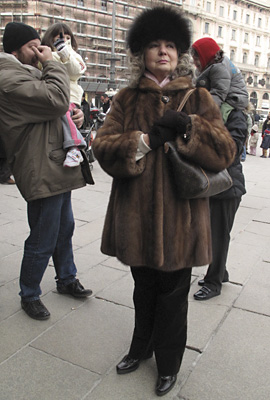
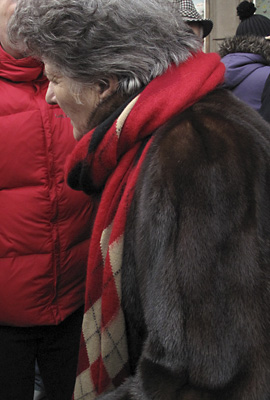
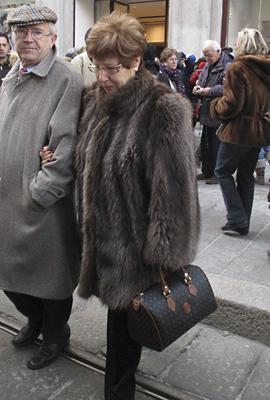
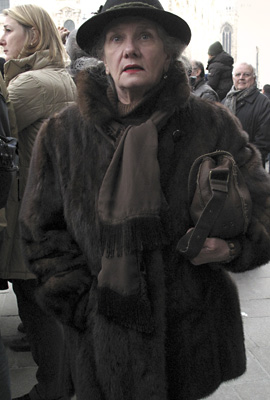

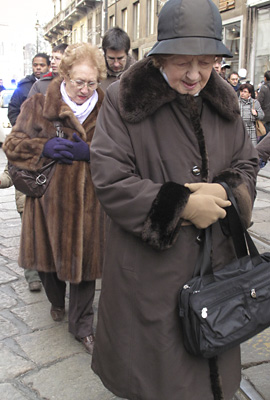
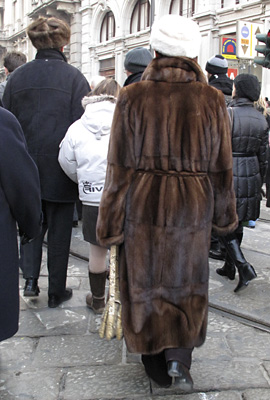
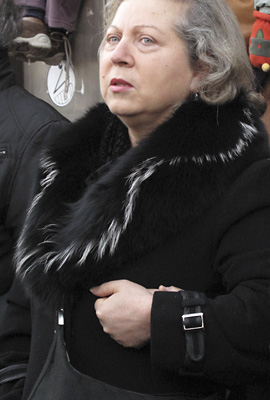
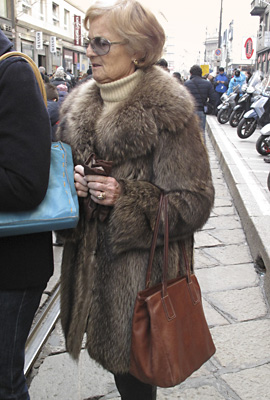
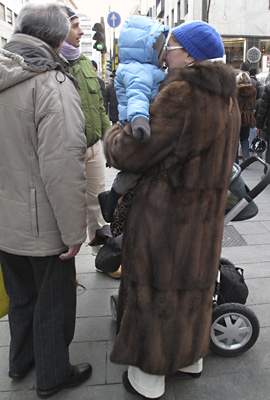
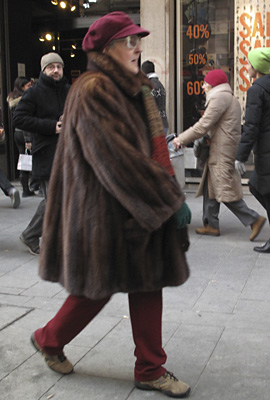
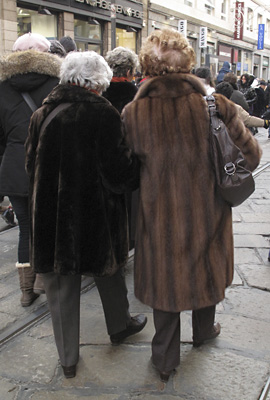
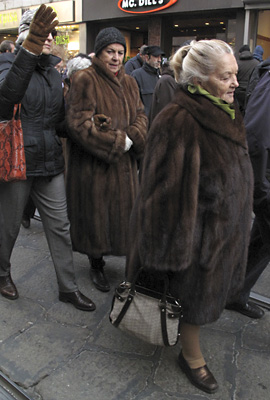
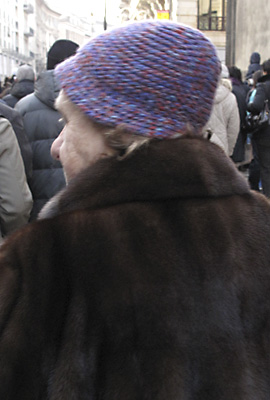
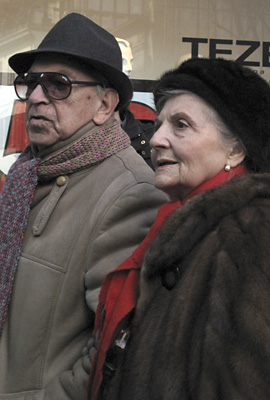
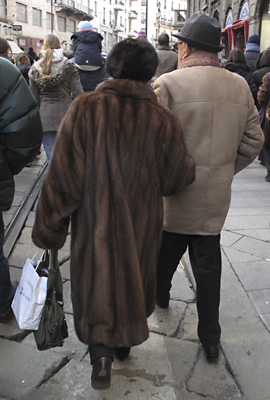
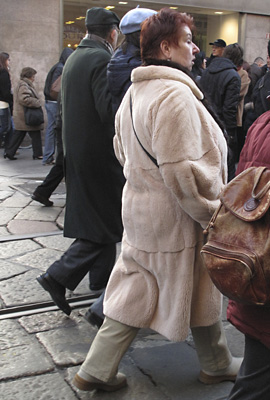
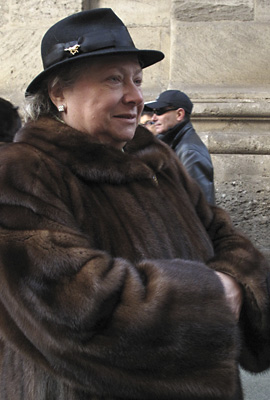
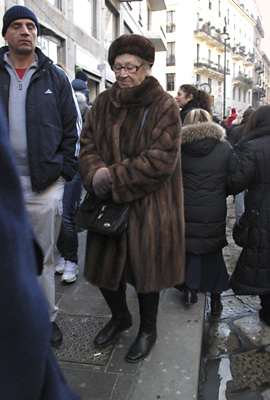
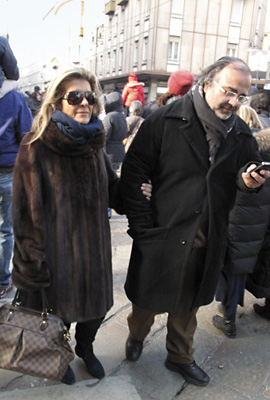
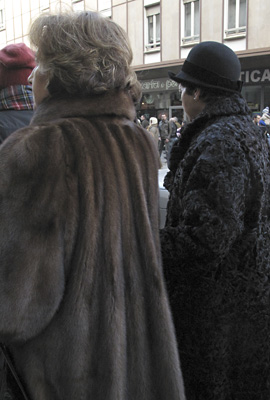
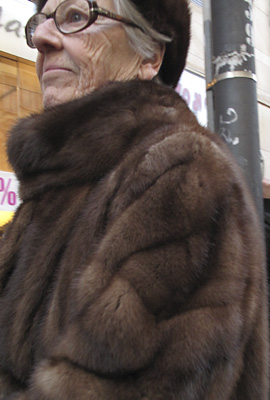
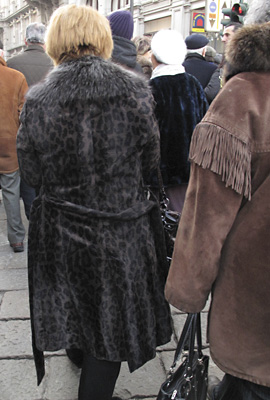
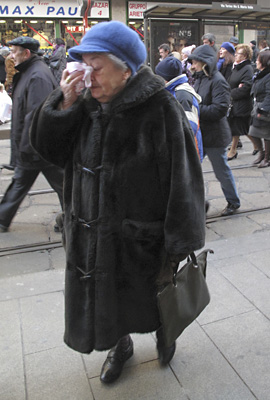
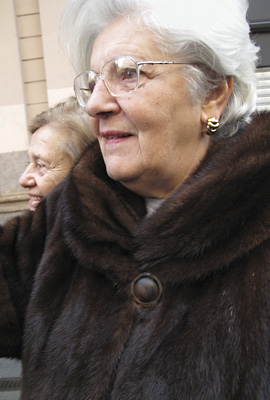
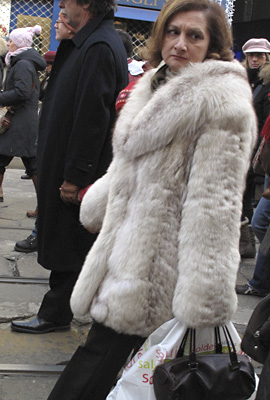
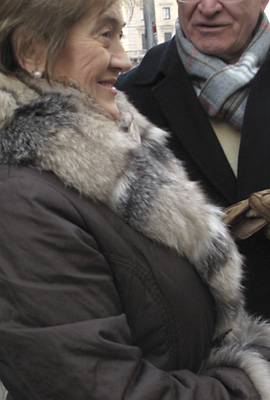
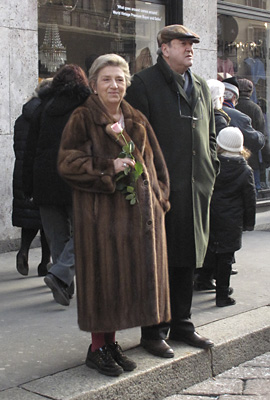
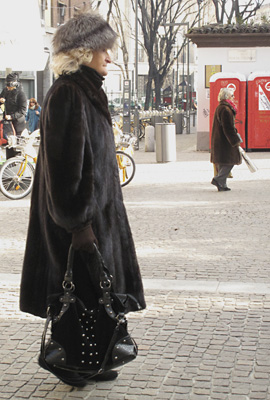
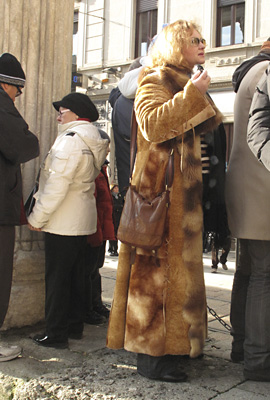
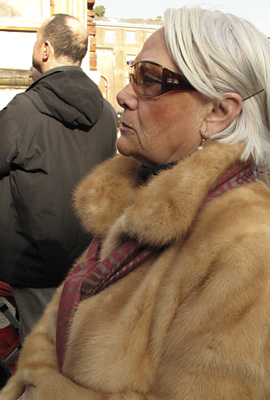
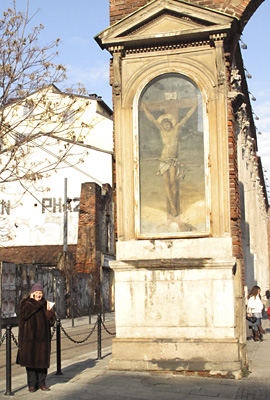
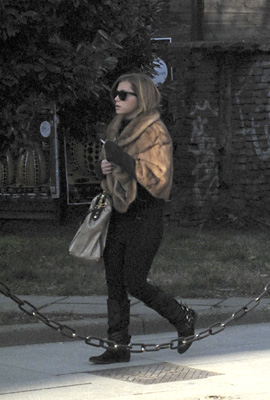
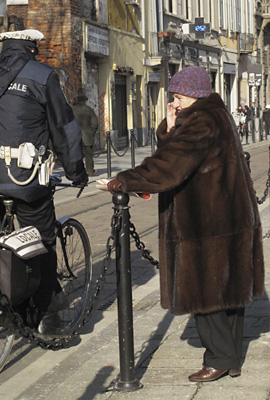
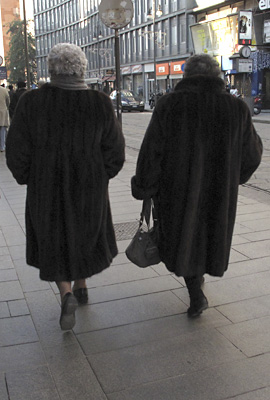
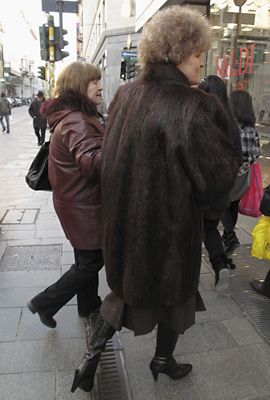
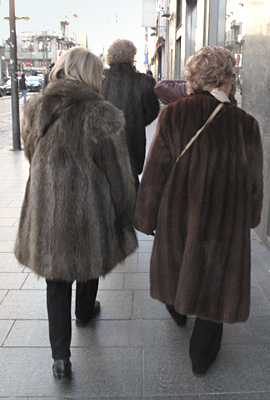
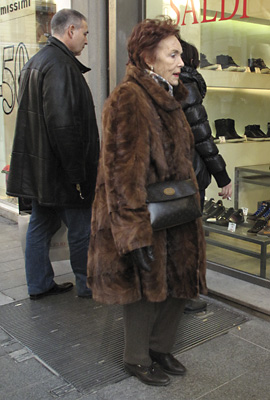
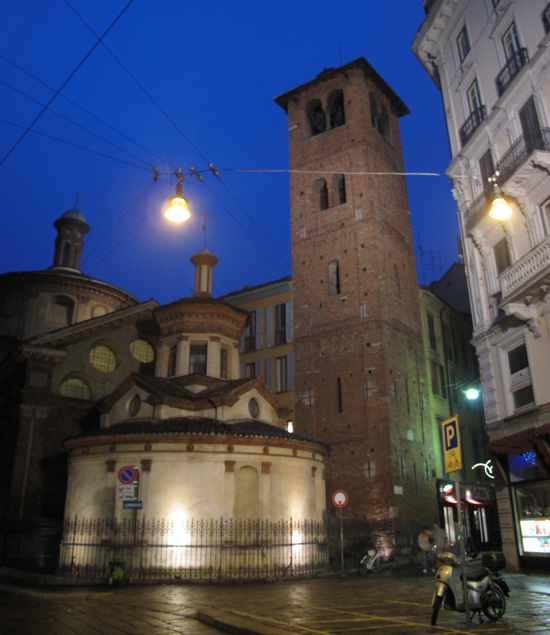
by Maureen | Jan 2, 2010 | Christmas & New Year's Eve, Discoveries, Introspection, Journal, People, Photos
From my journal entry, New Year’s Day 2010:
I took off walking toward the Duomo at 4:10 today. It’s New Year’s Day. I needed to get out of the house and get my body moving. I decided to zig zag through the “neighborhood” on streets I’ve never seen before, rather than take the sure, known route.
Along the way, an old woman approached me while walking her dog. She had seen me from a distance blowing my nose in my hankie. She rattled something off fast. “Non capisco,” I said finally. “What do you mean you don’t understand!?”, she said in Italian. We ended up comparing handkerchiefs. (Hers had embroidered flowers on white linen. Mine was deep magenta with big, off-white polka dots) I said I had handkerchiefs from my “nonna”.
She stood there in her patterned, fleece pants, just-this-side-of-pajamas and commented on the large size of my coat buttons. “Yes. They’re as big as plates!”, I said. “We could eat off them!” We both laughed, then wished each other a happy New Year and walked on.
It was late afternoon, getting on toward evening. The light was dimming and I was walking where I never had before. But I knew my general direction, took the lesser roads and kept moving. The streets were vacant. Hardly a car. Not a pedestrian. But as I neared the area of the Duomo, a few more people appeared, a few more restaurants and cafés were open (no shops!) and the energy picked up.
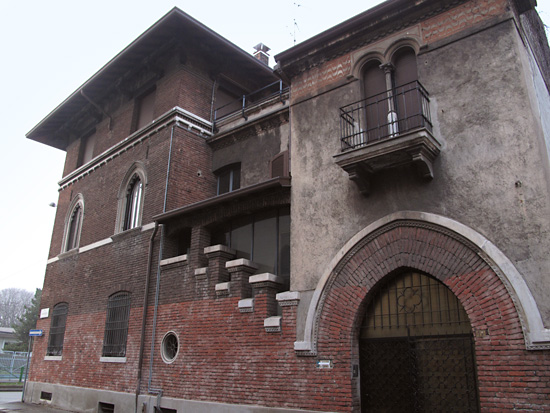
This house was in a cozy, little area of narrow streets, just north-east of me. What’s its history?!
I came to another street corner and stopped in my tracks at the sight of the Church of Santa Maria and San Satiro on a site originally established in 879 a.d. Where did that come from!? Just one block off the main drag through town! I had never seen it before.

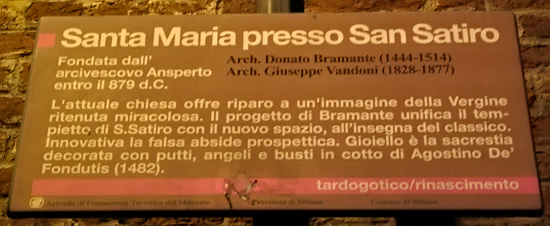
When I walked in, New Year’s Day evening, a small group of people was being led aloud in saying the rosary. I chimed in in English while I was there.
Heading for Monte Napoleone to see the window displays, I went north and to the east. The shops along that exclusive, narrow street are outside of my reach or comprehension. Actually shopping there is not a thought. My real goal was getting exercise and being out of the house, so I simply strolled and looked and shot a few photos until I got hungry.
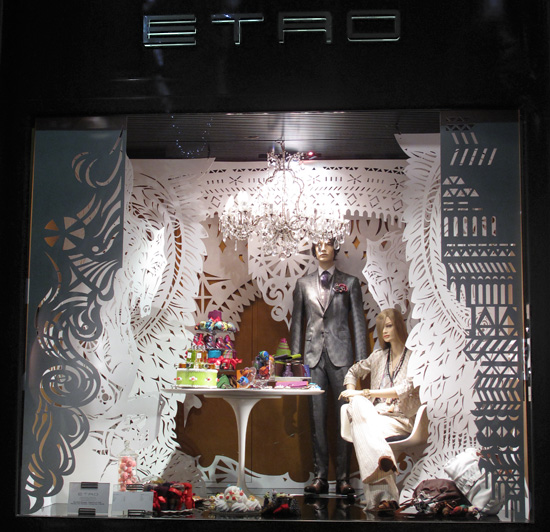
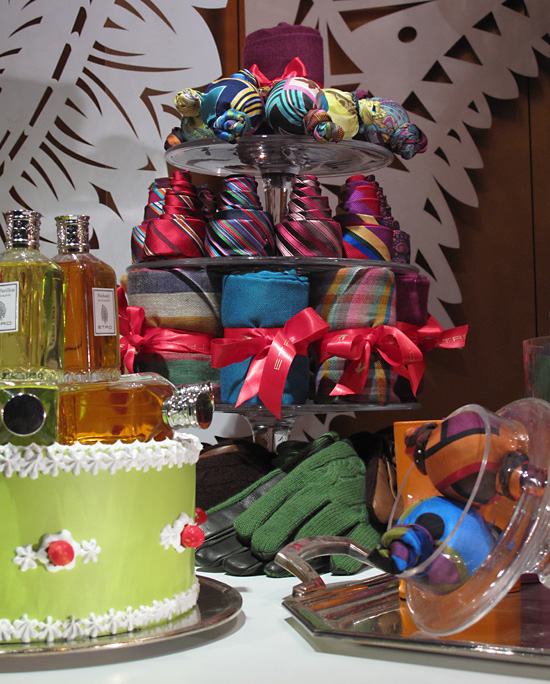
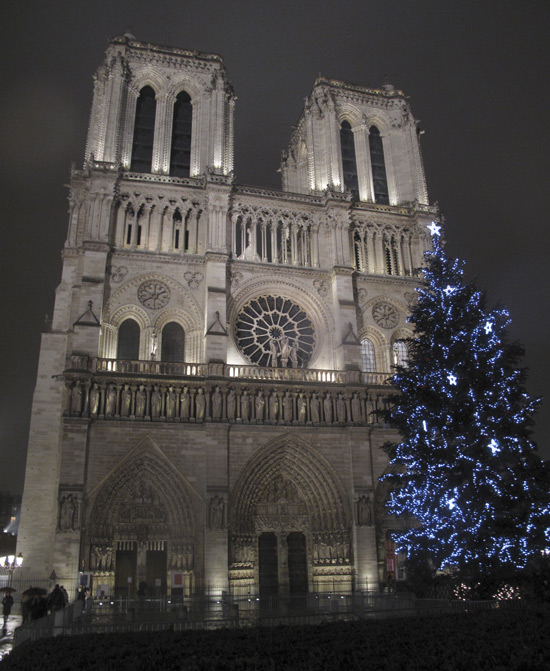
by Maureen | Dec 26, 2009 | Christmas & New Year's Eve, Featured Articles, Journal, Paris
It seemed to me that the ultimate Parisian, Catholic experience would be attending Midnight Mass on Christmas Eve. (And it seemed the thought occurred to thousands of others, too.) It was raining last night at 8:00 as I walked from my hotel, across the bridge and toward the cathedral. What a sight with the church illuminated in the blustery, late evening!
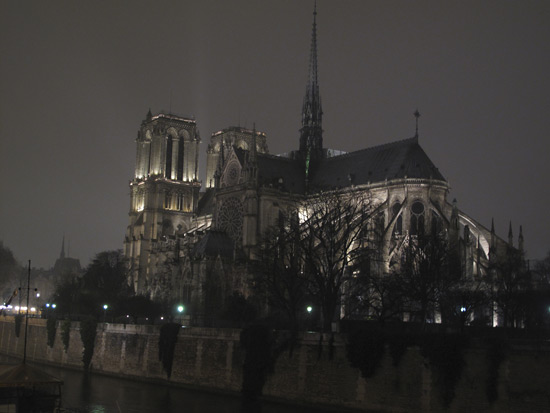
I walked around to the plaza in front of Notre Dame, and it was incredibly beautiful with the lights and the Christmas tree. (No. I didn’t retouch or recolor the image to make the tree look blue.)

When I arrived just after 8:00, there was another mass going on, so I walked around and looked at the side chapels. Toward the end of that mass, I and countless others, positioned ourselves, ready. Within little more than 5 minutes after the end of mass ALL of the chairs (no pews) were full of those that had been waiting. A short time later, an image/light show, “Lumen de Lumine”, was projected on a taut panel of fabric, suspended above the altar. It was a narrated (in French) picture story of the birth of Christ.
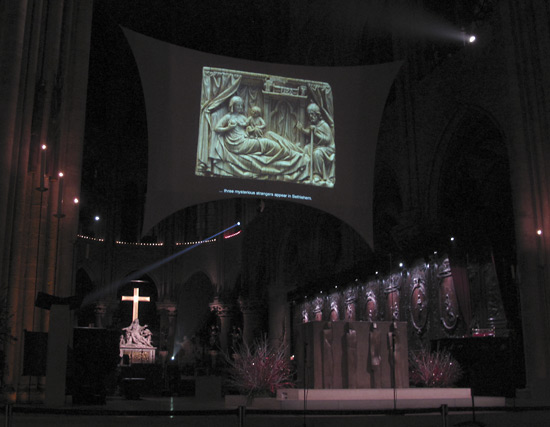
The light show was followed by Christmas songs sung beautifully in both French and English. When they sang “Silent Night” in French and invited the participation of the congregation, I sang aloud in English. I imagine others did, too.
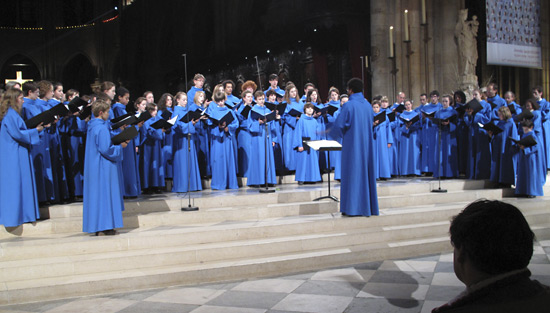
There were 6 little choir kids without blue robes, like this little girl. She was SO little and so young, yet so very intent on her singing.
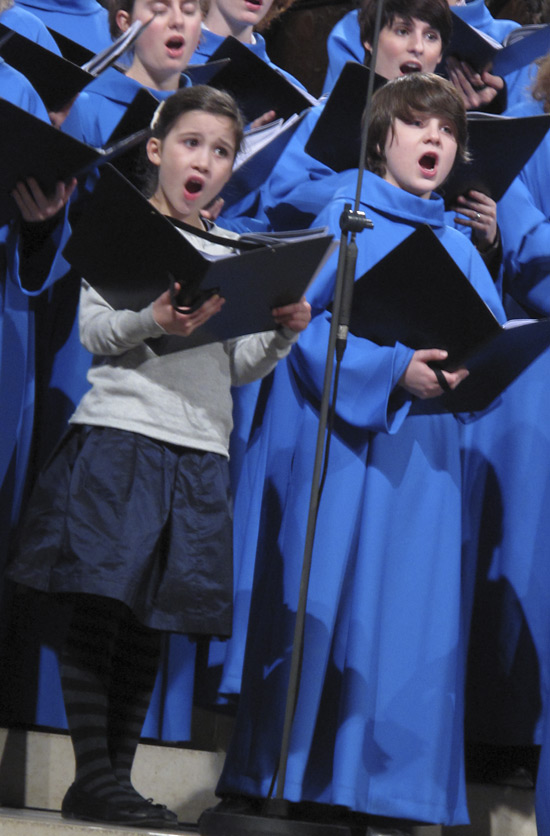
I don’t know how many people fit in that cathedral, but it was standing-room-only, even out into the small side chapels.
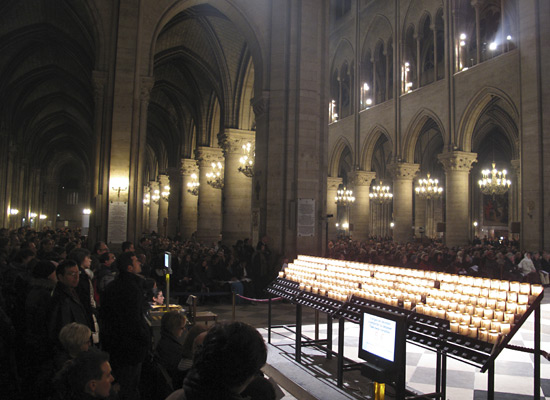
Notre Dame has a grand organ and it accompanied the choir and priests.
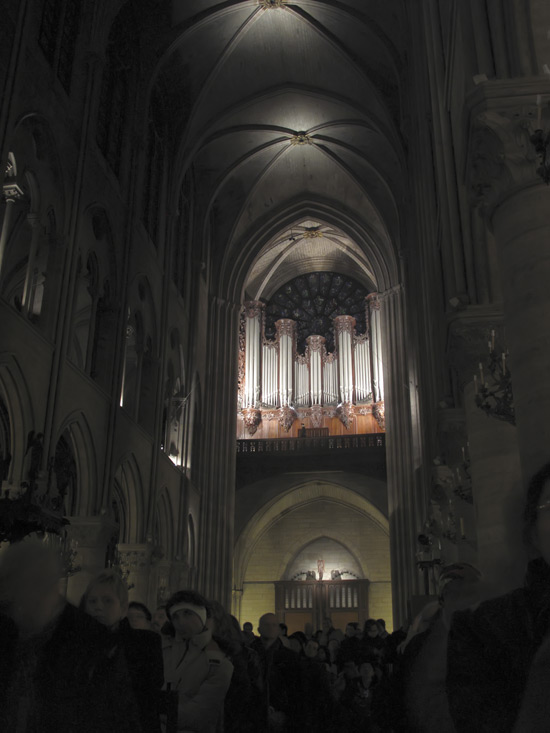
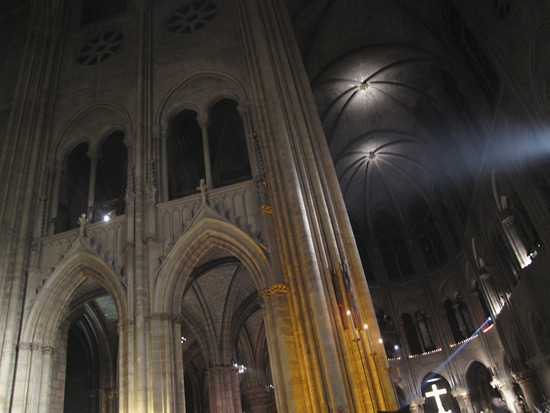
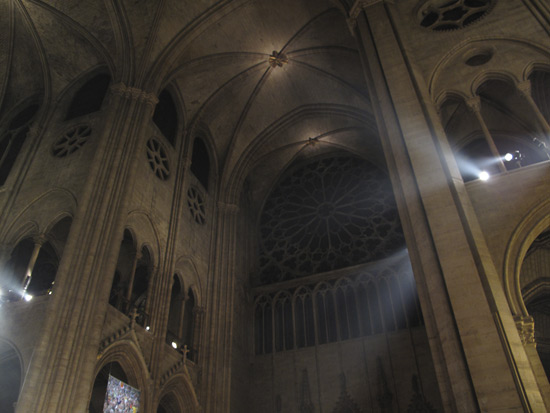
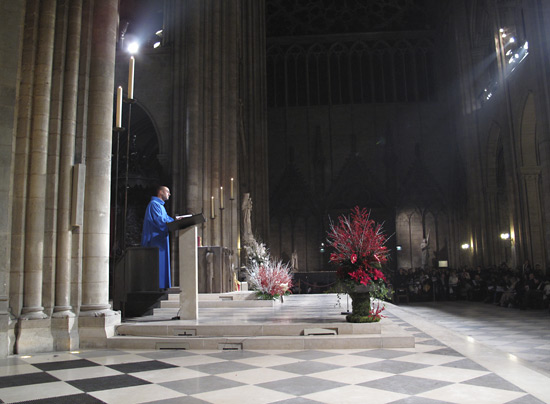
There were about 20 priests present to assist with communion, though they did not concelebrate. The mass was in French, with a few responsorials in Latin. It might as well have been a Latin high mass, though. A foreign language in a cathedral like that… it had the SENSE of a high mass.
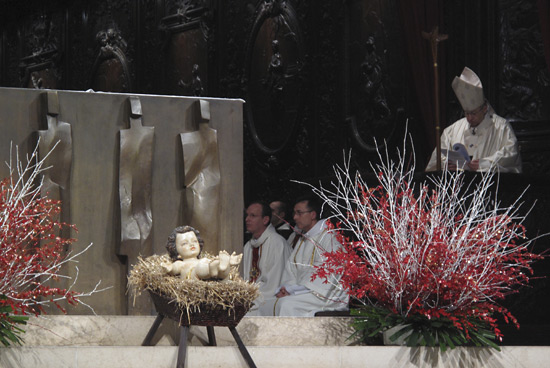
I was seated just 3 rows back from the front, so the frankincense was thick and fragrant. I like it.
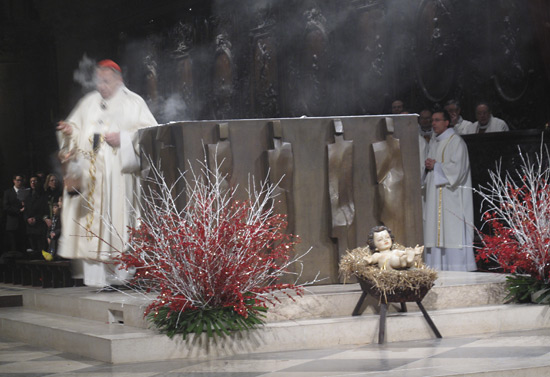
I had arrived just after 8:00 in the evening, and was leaving at 1:30 in the morning. What a memorable life experience: Midnight Mass at Notre Dame. The rain had stopped, and as I walked home to my hotel room, I could hear the church bells pealing loudly all the way.
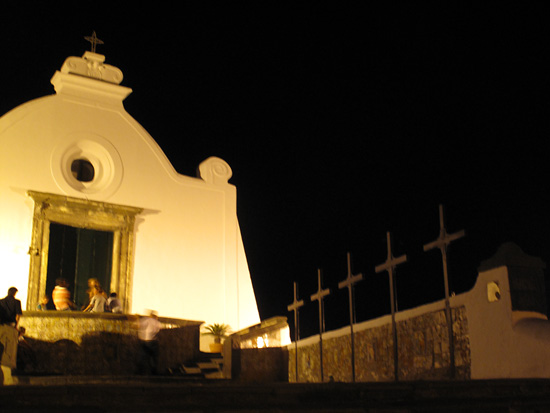
by Maureen | Aug 10, 2009 | Featured Articles, Journal, L'Isola d'Ischia, Photos
La Chiesa della Madonna del Soccorso – The Church of the Madonna of Help is located at the edge of a prominent cliff in Forio, at the west edge of the island of Ischia. I had seen it in the daytime from the window of the bus crowded with tourists, but was in no position to stop and go there.
The other night, however, after our prosciutto, pizza and limoncello, Glenda’s friend Ciro, our host for the evening, took us for a wild drive to Forio. (Only one that knows the roads drives like that! Ischia is NOT a place I’d recommend renting a car while on vacation. Leave those roads to the locals!) I was thrilled when Ciro stopped at the church, all lit up for the evening. I had the luxury of wandering around and shooting for as long as I wished. (Unfortunately, they were all hand-held night shots, so they’re “soft”. Still some fun images.)
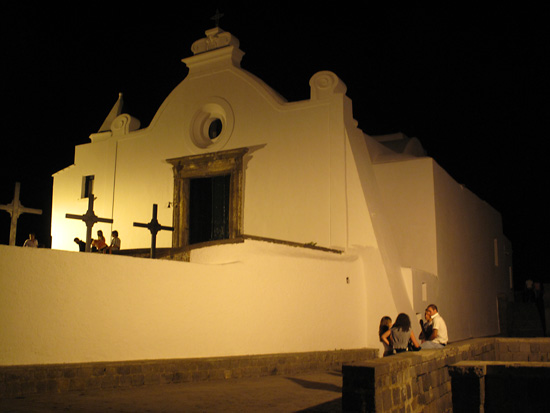
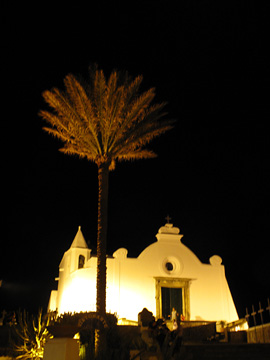
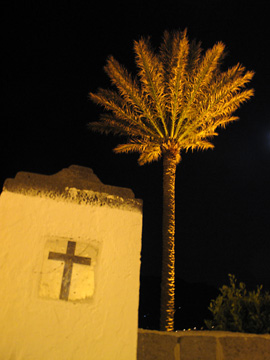

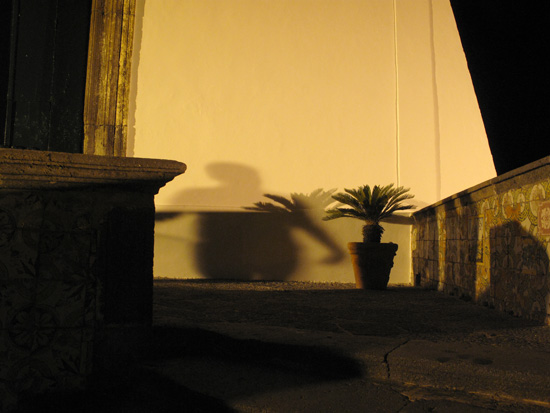
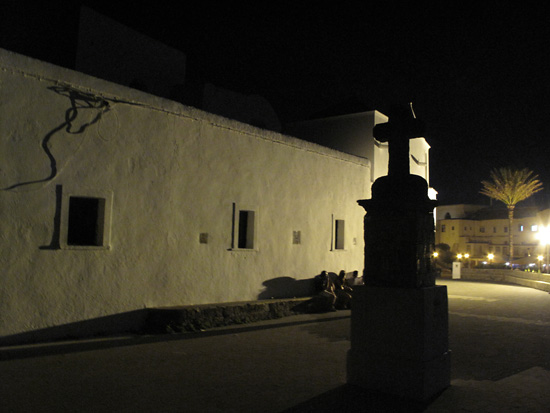
One of the government buildings in the town of Forio.
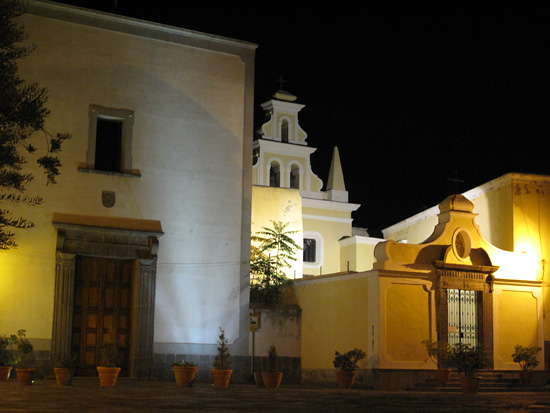
Ciro and Glenda at Chiesa del Soccorso.
